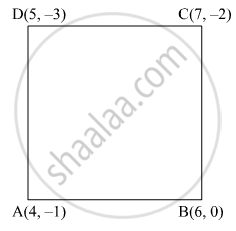Advertisements
Advertisements
Question
Show that A(4, –1), B(6, 0), C(7, –2) and D(5, –3) are vertices of a square.
Solution

The given points are A(4, –1), B(6, 0), C(7, –2) and D(5, –3).
AB = \[\sqrt{\left( 6 - 4 \right)^2 + \left( 0 + 1 \right)^2} = \sqrt{4 + 1} = \sqrt{5}\]
BC =\[\sqrt{\left( 6 - 7 \right)^2 + \left( 0 + 2 \right)^2} = \sqrt{1 + 4} = \sqrt{5}\]
CD =\[\sqrt{\left( 7 - 5 \right)^2 + \left( - 2 + 3 \right)^2} = \sqrt{4 + 1} = \sqrt{5}\]
AD = \[\sqrt{\left( 5 - 4 \right)^2 + \left( - 3 + 1 \right)^2} = \sqrt{1 + 4} = \sqrt{5}\]
AB = BC = CD = DA
Slope of AB = \[\frac{0 + 1}{6 - 4} = \frac{1}{2}\]
Slope of BC = \[\frac{- 2 - 0}{7 - 6} = - 2\]
Slope of CD = \[\frac{- 3 + 2}{5 - 7} = \frac{1}{2}\]
Slope of AD = \[\frac{- 3 + 1}{5 - 4} = - 2\]
Thus, AB perpendicular to BC and AD. Also, CD perpendicular to AD and AB.
So, all the sides are equal to each other and are perpendicular.
Thus, they form a square.
APPEARS IN
RELATED QUESTIONS
A slope of a line is 3 and y-intercept is –4. Write the equation of a line
The line passing through (−4, −2) and (2, −3) is perpendicular to the line passing through (a, 5) and (2, −1). Find a.
The points (K, 3), (2, −4) and (−K + 1, −2) are collinear. Find K.
Find the slope of the line which is perpendicular to `x/3 - 2y = 4`
Lines 2x – by + 5 = 0 and ax + 3y = 2 are parallel to each other. Find the relation connecting a and b.
Find the slope of the line passing through the points G(4, 5) and H (–1, –2).
Find k, if R(1, –1), S (–2, k) and slope of line RS is –2.
Fill in the blank using correct alternative.
Out of the following, point ........ lies to the right of the origin on X– axis.
Find the slope of a line, correct of two decimals, whose inclination is 60°
Find the slope of a line passing through the given pair of points (3,7) and (5,13)
Find the slope of a line parallel to the given line 4x-2y = 3
Find the slope and the y-intercept of the following line 3x + y = 7
Find slope of a line passing through the points A(3, 1) and B(5, 3).
Find the value, of k, if the line represented by kx – 5y + 4 = 0 and 4x – 2y + 5 = 0 are perpendicular to each other.
Show that the line joining (2, – 3) and (- 5, 1) is:
(i) Parallel to line joining (7, -1) and (0, 3).
(ii) Perpendicular to the line joining (4, 5) and (0, -2).
The line through P (5, 3) intersects Y axis at Q.
(i) Write the slope of the line.
(ii) Write the equation of the line.
(iii) Find the coordinates of Q.
Find the slope of the line passing through given points G(3, 7) and K(–2, –3).
If the lines kx – y + 4 = 0 and 2y = 6x + 7 are perpendicular to each other, find the value of k.
